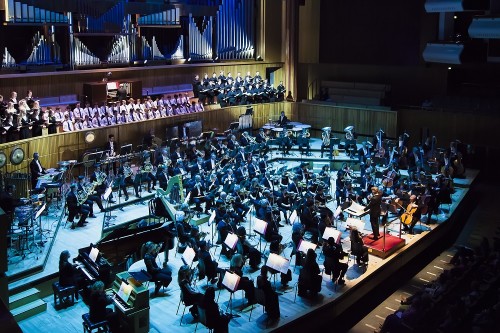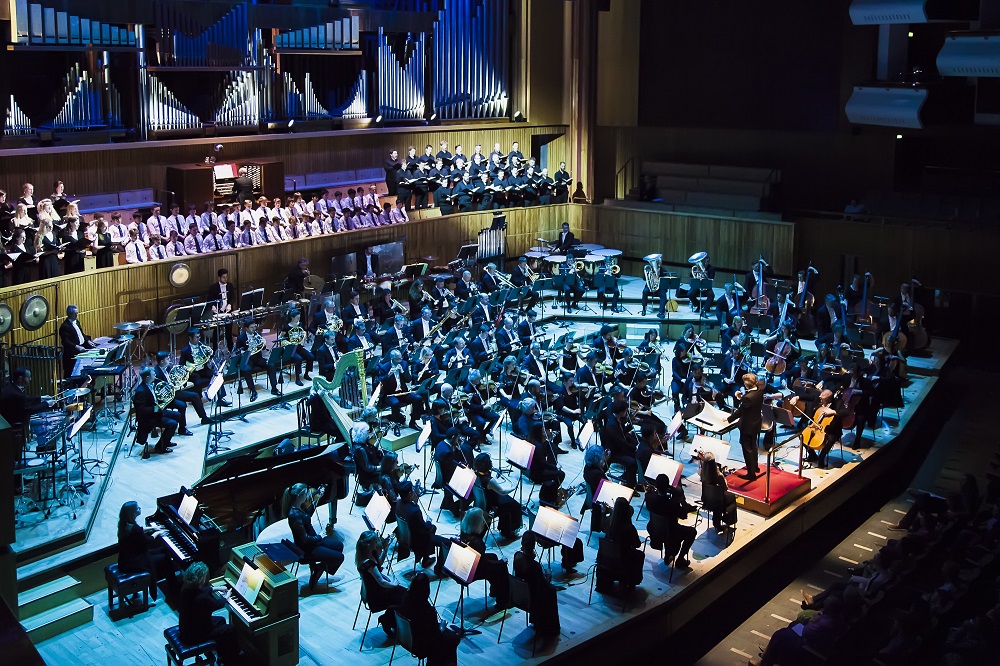 United Kingdom Biber, Beethoven, Chin: Trinity Boys Choir, Philharmonia Voices, Philharmonia Orchestra / Esa-Pekka Salonen (conductor). Royal Festival Hall, London, 15.4.2018. (CC)
United Kingdom Biber, Beethoven, Chin: Trinity Boys Choir, Philharmonia Voices, Philharmonia Orchestra / Esa-Pekka Salonen (conductor). Royal Festival Hall, London, 15.4.2018. (CC)

Biber – Battaglia
Beethoven – Symphony No.2 in D, Op.36
Unsuk Chin – Le Chant des Enfants des Étoiles (European premiere)
Quite a variety here, from Biber (1644-1704) to Unsuk Chin (born 1961). It was typically adventurous programming from Salonen, with the added draw of a European premiere (Chin’s piece was premiered in 2016 at the opening of a Seoul concert hall).
The Biber Battaglia (1673) is an eight-movement piece for nine string parts plus continuo. Performed with standing string players (those who could), Salonen’s reading was bright and fresh. The ‘snap’ pizzicatos were effective and the somewhat predictive-Stravinskian layering of tonalities in the second movement, ‘Die Liederliche Gesellschaft von allerley Humor’ (The dissolute society of all sorts) were fascinating, especially when the music degenerated into a similar pre-echo of Mozart’s Musikalischer Spaß. A fascinating curio, and brilliantly performed, not least in the violin solos by Sarah Oates.
Beethoven’s Second Symphony is the one of the nine that doesn’t get out so often. It is a brilliant piece, and this was a streamlined performance, impeccably rehearsed. Yes, Salonen used a large string section but actually it sounded rather vibrant. The punchy, annunciatory opening brought with it the sound of natural trumpets and hard-stick timpani (modern valved horns, though). It would be easy to miss the virtuosity of the performance: those super-fast violin runs just so. Perhaps just the last edge of excitement was missing; the Larghetto, though, was beautifully paced, lean and beautiful. Those perilous high passages for horn claimed a victim three times out of four, but luckily not disastrously so, while the bass bite of the Scherzo brought real life to the performance.
The Chin is fascinating in conception: settings of texts, like the evening’s programme itself ranging from the Baroque to the present day, mainly but not exclusively in English. No texts in the programme or an insert, however, only subtitles, which left one feeling a little short-changed. Texts were by poets such as Fernando Pessoa and Juan Ramón Jiménez, Edith Södergran and Eeva-Liisa Manner, as well Henry Vaughan and Blake.
Lighting was used in a broad-brush way to illustrate the music, from the darkness of the opening (with its unison bell expanding outwards and conveying a sense, perhaps, of the Universe birthing itself) to colourful brush strokes across the organ. The cosmos is the basis for Chin’s work; more specifically, her self-admitted fascination with astronomy and physics. She reflects on phenomena and our place as humans in relation to them, a process which in itself should be able to give us an enlarged viewpoint – an important point particularly now, perhaps, when one considers a world becoming more and more insular and combative.
The scoring is for huge forces, and includes a substantial part, including what appears to be a cadenza, for the RFH organ; the percussion department is predictably vast. There is a children’s chorus (the Trinity Boys Choir, on absolute top form) as well as the main full chorus. Chin, delivering a piece of some 40 minutes, divides her twelve movements into two groups of six. Right from the opening, the voices sing of ‘indefinite space’. Interesting that at first at least, the boys’ choir performed from memory, an angelic force in a universe of mysteries.
Chin’s musical vocabulary has always been pretty uncompromising, and so it was here. There was a distinct feeling of ritualism about some passages; at others one could talk about a Stravinskian angularity of line. The title seems to invoke the spirit of Messiaen, but the music only occasionally does. Instead, a voice of consistent language and vocabulary emerges. Despite the mammoth forces, Chin impresses most at moments of miraculously fragile scoring.
Perhaps the line ‘Listen to the light singing’ sums up best what Chin was trying to achieve. Never one to shy away from challenges, Chin’s piece is always fascinating, and for the listener its duration flies by. The performance itself had supreme confidence from first to last. Salonen’s background in contemporary music is well-known, and he conducted with what appeared to be a deep knowledge of the score. One hopes for a recording of Le Chant des Enfants des Étoiles for the score to reveal more of its secrets.
Colin Clarke
